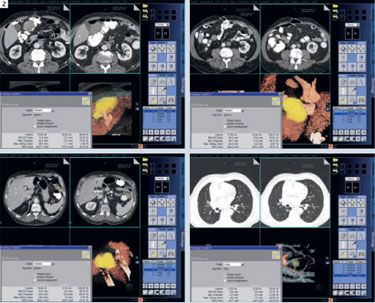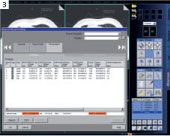Improved Evaluation and Follow-up of Routine Diagnostic Oncology Exams
Diagnostic, staging and follow-up exams for tumors are among the most frequent CT exams performed in many radiology departments. For the University of Erlangen, oncology related imaging represents approximately 60% of the daily CT workload. To date, exams are read and evaluated in 2D, employing manual measurement and reporting of lesions.
Diagnostic, staging and follow-up exams for tumors are among the most frequent CT exams performed in many radiology departments. For the University of Erlangen, oncology related imaging represents approximately 60% of the daily CT workload. To date, exams are read and evaluated in 2D, employing manual measurement and reporting of lesions. For follow-up exams, previously reported lesions must be manually located, and are often re-measured for size comparison with the current exam. This relatively time-consuming manual process is therefore prone to intra- and inter-reader variability, with the potential for sub-optimal outcomes.
Recently a number of automated or semiautomated 2D/3D, and CAD software tools have become available to assist in the evaluation, reporting and follow-up of lung and colon lesions. These have proved extremely useful in improving diagnostic outcomes, delivering reliable performance in everyday clinical routine – increasing reader confidence and shortening evaluation time.1–3 However, these automated tools do not cover the evaluation of lymph nodes and liver nodules, for example, which together with the evaluation of lung lesions are the bread and butter imaging of clinical routine. syngo® CT Oncology* is a new software, which offers automated workflows for the 3D evaluation and follow-up of tumors in the liver and in the lung, incorporating lung CAD. There is also a dedicated algorithm for lymph nodes, plus a generic algorithm for other tumors throughout the body – such as malignant melanoma, as in the case presented here.
HISTORY
A 70-year-old man underwent a routine follow-up CT exam at three months while undergoing chemotherapy for malignant melanoma. The software facilitates 3D lesion segmentation and delivers standard lesion parameters: RECIST, WHO and volume (Fig. 1). The automated lesionmatching marked previously reported lesions in the follow-up exam and the percental change in lesion parameters were automatically calculated and sent to the DICOM SR (Fig. 2). Doubling time and tumor burden are also automatically calculated and as a useful eye catcher, tumor burden is highlighted in red, demonstrating significant growth of marked lesions (Fig. 3). A great time saver is the ability to switch between lung and soft tissue windows, for example, which means that lung nodules (Figs. 1 and 2) can be easily evaluated at the same time, without loading a new data set. All lesion parameters are included in the same report.
DIAGNOSIS AND COMMENTS
Preliminary experiences with syngo CT Oncology** suggest a great potential for improving all aspects of routine workflow by allowing us to deliver objective, reliable and consistent tumor evaluation and follow-up measurements which are less prone to inter- and intra-reader variability, allowing us to deliver a more standardized output. Additionally, the automated lesion matching could help to save valuable time in follow-up exams.
1 Graser, A. and Becker, C. R. (2005)
SOMATOM Sessions 17.
2 Das, M. et al (2006) SOMATOM Sessions 19.
3 Mang, T. et al (2007) Eur Radiol Mar 10.
Automated lesion matching identified the previously identified lesions in the follow-up exam. The percental change in basic tumor parameters were automatically calculated and presented in the report.

[Fig. 1] Identification of 3 intraabdominal lesions and 1 of 2 lung lesions marked for 3 month follow-up. Lesions can be viewed in axial, coronal, sagittal and VRT views. Basic lesion parameters are presented in a DICOM SR compatible report. Lung lesions were identified in the same dataset by switching to a lung window.

[Fig. 2] Automated lesion matching identified the previously identified lesions in the follow-up exam. The percentage change in basic tumor parameters were automatically calculated and presented in the report.

[Fig. 3] Signifi cantly increased tumor burden is marked in red in the report. The percentage change in RECIST, WHO, 3D volume and doubling time of all lesions are automatically calculated and included in the DICOM SR compatible report.
EXAMINATION PROTOCOL
Scanner SOMATOM Sensation 64-slice configuration
Scan area Thorax-Abdomen
Pitch 1.2
Scan length 686 mm
Reconstruction increment 0.8 mm
Scan time 15 s
Kernel B4If
Scan direction cranio-caudal
Contrast
kV 120 kV Volume 100 ml
Effective mAs 150 mAs
Flow rate 3 ml / s
Rotation time 0.5 s
Postprocessing
Slice collimation 0.6 mm
syngo CT Oncology
Spatial resolution 0.33 mm
Slice width 1 mm
GE HealthCare Debuts AI-Powered Cardiac CT Device at ACC Conference
April 1st 2025Featuring enhanced low-dose image quality with motion-free images, the Revolution Vibe CT system reportedly facilitates improved diagnostic clarity for patients with conditions ranging from in-stent restenosis to atrial fibrillation.
The Reading Room Podcast: Current Perspectives on the Updated Appropriate Use Criteria for Brain PET
March 18th 2025In a new podcast, Satoshi Minoshima, M.D., Ph.D., and James Williams, Ph.D., share their insights on the recently updated appropriate use criteria for amyloid PET and tau PET in patients with mild cognitive impairment.